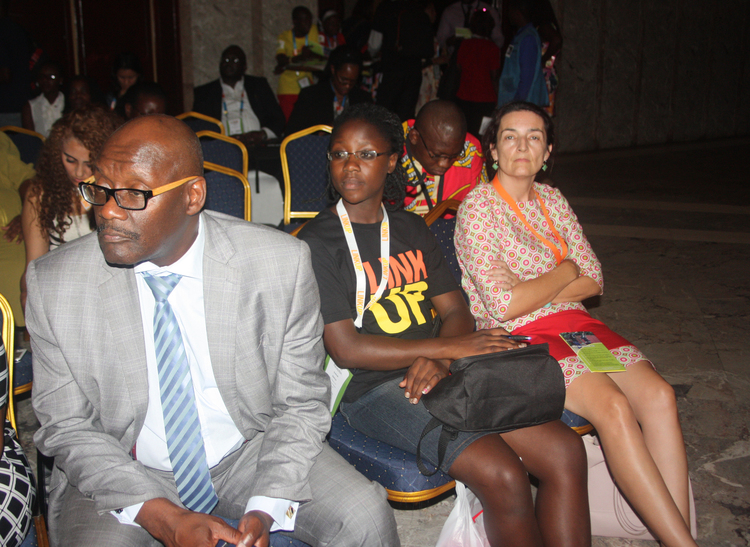
The Sunday Mail

The failure by the “Berlin Patient” and Samuel Eto’o, one of Africa’s top footballers, to attend the International Conference on Aids and Sexually Transmitted Infections in Africa (ICASA) did not remove the gloss from Africaa’s biggest such indaba.
Timothy Ray Brown, referred to as the “Berlin Patient”, had HIV for 12 years before he became the first person in the world to be cured of the infection following a cell transplant in 2007.
He remains the only person to have been functionally cured of this otherwise incurable disease.
The case of the Berlin Patient has captivated HIV and Aids researchers.
At ICASA, Brown was expected to recall his many years of illness, to recount the series of difficult decisions he made and chronicle his road to recovery.
Brown’s account, which was advertised as a gripping first-person account, would have been one of the event’s major highlights.
Organisers said Brown failed to attend the conference because of “ill-health”.

Dr David Parirenyatwa (left) , the Minister of Health and Child Care listens attentively during one of the ICASA sessions-Picture by Prudence Mpofu
Eto’o, one of the most decorated soccer stars from the continent and a four-time African Player of the Year, was also billed to address young people on HIV and sexually transmitted infections.
The prolific striker did not pitch up.
The absence of the duo did not, however, dampen the spirits of the more than 5 000 delegates from nearly 150 countries.
Delegates included researchers, activists, scientists, clinicians and policy-makers.
Beamed across the world via satellite, the conference theme was “Linking Leadership, Science and Human Rights in the Post-2015 Era”.
Workshops, plenary sessions, satellite symposia, exhibitions and cultural activities were part of this lively, week-long event.
Delegates discussed issues related to funding, the HIV incidence in Africa, HIV and Aids and STI prevalence in adolescents.
One of the conference’s major talking points was the “Condomise” campaign, which proved to be an innovative way of distributing the latex sheaths.
Of the numerous solid presentations made, one by Dr Julitta Onabanjo, the Unicef East and Southern Africa regional director, was particularly revealing.
Dr Onabanjo laid bare the problems faced by women in the fight against HIV and Aids.
It was noted that in Africa south of Sahara, women acquire HIV five to seven years earlier than men and that globally every year, there are more than 380 00 new infections among adolescent girls and young women.
An estimated 80 percent of young women aged 15-24 living with HIV are in Africa south of the Sahara Africa and that 74 percent of the new infections in the region are among adolescent girls.
Dr Onabanjo said there was need to empower women and girls, who are often vulnerable to violence, child marriage, unsafe sex and a lack of access to sexual and reproductive health information and services.
According to the United Nations Populations Fund, between 2005 and 2013, new HIV infections among adults declined by more than 50 percent in Ethiopia, Malawi and Rwanda and between 30 and 50 percent in Botswana, Eritrea, Namibia, Tanzania, South Africa, Swaziland, Zambia and Zimbabwe.
The overall estimated number of new infections in the region declined by 32 percent in that period.
The African Union Common Position on HIV and Aids in the Post-2015 Era highlighted the need to bring the HIV epidemic under control so that it no-longer represent a public health threat through the reduction, by 90 percent, of new infections.
The AU is making efforts to reduce stigma and discrimination and Aids-related deaths by the same margin.
Stakeholders described the conference as a success and said follow-ups must be made to ensure objectives were implemented.
Efforts are being made to achieve an Aids-free Africa by 2030.
The continent has one of the largest population of people living with HIV and Aids in the world. An estimated 69 percent of the people living with HIV and Aids on the continent are Africa south of the Sahara.
Last year, Africa accounted for 70 percent of Aids-related deaths worldwide even though the continent is home to just 15 percent of the global population.
. . . ‘Condomise’ campaign steals spotlight
Sharon Kavhu
The “Condomise” campaign, which was launched during the 18th edition of the International Conference on Aids and other Sexually Transmitted Infections in Southern Africa proved to be one of the major highlights of the conference.
Government, through the Ministry of Health and Child Care, joined forces with the United Nations Population Fund (UNFPA) to come up with this campaign to promote condom usage.
A variety of condom designs were unveiled during the campaign.
Some of the condom designs resemble animals while some condoms were glowing in the dark.
Ms Bidia Deperthes, a senior technical advisor with the UNFPA explained the campaign’s concept.
“People need a variety in everything. As such, we came up with different types of condoms in different shapes, scents, colours and design. We did this to encourage people to use condoms,” Ms Deperthes said.
Prior to the ICASA launch, a three-day campaign was held in Chitungwiza, Mufakose, Mbare, Epworth and Highfield where over 200 000 condoms were distributed.
Similar campaigns have been launched in Botswana, Swaziland, Malawi, Togo, Ethiopia and Zambia.
During the campaigns, people are encouraged to practice safe sex.
Ms Anna Machiya, the National Sexually Transmitted Infection, Prevention and Condom Co-ordinator in the Ministry of Health and Child Care said the campaign also targeted women.
“Women are in the most vulnerable group when it comes to condom usage. The majority of women cannot negotiate for safe sex because of the cultural belief that men dominate the act. Women should have the confidence to negotiate for safe sex,” she said.



